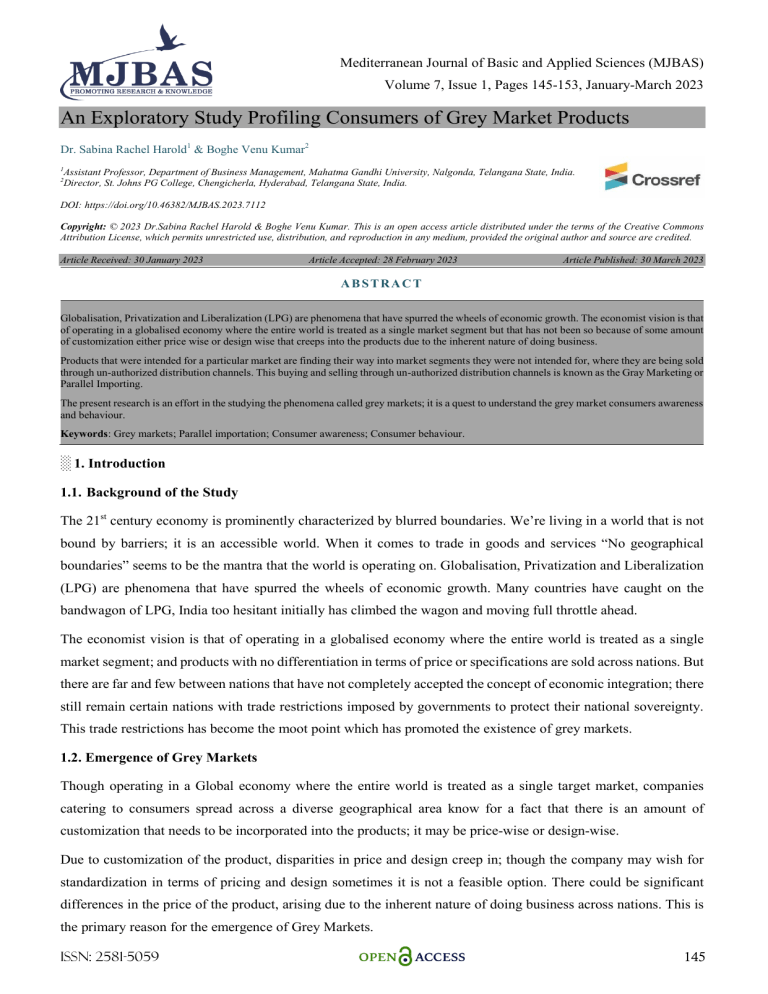An Exploratory Study Profiling Consumers of Grey Market Products
advertisement

Mediterranean Journal of Basic and Applied Sciences (MJBAS) Volume 7, Issue 1, Pages 145-153, January-March 2023 An Exploratory Study Profiling Consumers of Grey Market Products Dr. Sabina Rachel Harold1 & Boghe Venu Kumar2 1 Assistant Professor, Department of Business Management, Mahatma Gandhi University, Nalgonda, Telangana State, India. Director, St. Johns PG College, Chengicherla, Hyderabad, Telangana State, India. 2 DOI: https://doi.org/10.46382/MJBAS.2023.7112 Copyright: © 2023 Dr.Sabina Rachel Harold & Boghe Venu Kumar. This is an open access article distributed under the terms of the Creative Commons Attribution License, which permits unrestricted use, distribution, and reproduction in any medium, provided the original author and source are credited. Article Received: 30 January 2023 Article Accepted: 28 February 2023 Article Published: 30 March 2023 ABSTRACT Globalisation, Privatization and Liberalization (LPG) are phenomena that have spurred the wheels of economic growth. The economist vision is that of operating in a globalised economy where the entire world is treated as a single market segment but that has not been so because of some amount of customization either price wise or design wise that creeps into the products due to the inherent nature of doing business. Products that were intended for a particular market are finding their way into market segments they were not intended for, where they are being sold through un-authorized distribution channels. This buying and selling through un-authorized distribution channels is known as the Gray Marketing or Parallel Importing. The present research is an effort in the studying the phenomena called grey markets; it is a quest to understand the grey market consumers awareness and behaviour. Keywords: Grey markets; Parallel importation; Consumer awareness; Consumer behaviour. ░ 1. Introduction 1.1. Background of the Study The 21st century economy is prominently characterized by blurred boundaries. We’re living in a world that is not bound by barriers; it is an accessible world. When it comes to trade in goods and services “No geographical boundaries” seems to be the mantra that the world is operating on. Globalisation, Privatization and Liberalization (LPG) are phenomena that have spurred the wheels of economic growth. Many countries have caught on the bandwagon of LPG, India too hesitant initially has climbed the wagon and moving full throttle ahead. The economist vision is that of operating in a globalised economy where the entire world is treated as a single market segment; and products with no differentiation in terms of price or specifications are sold across nations. But there are far and few between nations that have not completely accepted the concept of economic integration; there still remain certain nations with trade restrictions imposed by governments to protect their national sovereignty. This trade restrictions has become the moot point which has promoted the existence of grey markets. 1.2. Emergence of Grey Markets Though operating in a Global economy where the entire world is treated as a single target market, companies catering to consumers spread across a diverse geographical area know for a fact that there is an amount of customization that needs to be incorporated into the products; it may be price-wise or design-wise. Due to customization of the product, disparities in price and design creep in; though the company may wish for standardization in terms of pricing and design sometimes it is not a feasible option. There could be significant differences in the price of the product, arising due to the inherent nature of doing business across nations. This is the primary reason for the emergence of Grey Markets. ISSN: 2581-5059 145 Mediterranean Journal of Basic and Applied Sciences (MJBAS) Volume 7, Issue 1, Pages 145-153, January-March 2023 DIFFERENCES ACROSS NATIONS Cultural Cost of Production CUSTOMIZATION OF PRODUCT EMERGENCE OF GREY MARKETS Figure 1. (SOURCE: Author) 1.3. What are Grey Markets? Products that were intended for a particular market are finding their way into market segments they were not intended for, where they are being sold through un-authorized distribution channels. This buying and selling through un-authorized distribution channels is known as the Gray Marketing or Parallel Importing. Grey Market Goods are “legal (different from black) and genuine (different from counterfeit) goods which are sold outside the normal distribution channels by the sellers, having no relationship with the manufacturer of the good”. 1.4. Review of Literature Parallel imports are goods traded without the authorization of an original trademark or copyright owner. A distributor receiving goods from a manufacturer at a low wholesale price can profitably sell the goods in another country, outside the authorized distribution channel (Maskus & Chen, 2002). A grey market occurs when an imported product is sold through an unauthorized channel and the brand owner's approval is lacking (Rao and Klein, 2003). Grey marketing is the import and/or sale of branded products by unauthorized distributors, into a market where these products are not supposed to be sold (Gupta and Gould, 1997). Grey marketing is the phenomenon of legally imported goods being resold through unauthorized channels (Lichtenstein et al., 1993). A study by Lichtenstein et al. (1995) found that consumers who engage in grey market purchases are often driven by a desire for lower prices, as well as a sense of adventure and excitement. Grey markets can lead to a decrease in prices and profits for manufacturers and authorized distributors (Chen and Chen, 1998). Consumers who engage in grey market purchases are often driven by a desire for lower prices, as well as a sense of adventure and excitement (Lichtenstein et al., 1995). Online sales channels can increase competition and reduce profits for legitimate sellers (Huang and Su, 2003). Grey market activity can have a negative impact on a brand's reputation and image (Xu and Chan, 2016). Grey market activity can disrupt supply chain operations, reduce sales volume, and increase costs for legitimate sellers (Zhang and Li, 2018). ISSN: 2581-5059 146 Mediterranean Journal of Basic and Applied Sciences (MJBAS) Volume 7, Issue 1, Pages 145-153, January-March 2023 Overall, the literature suggests that grey markets can have a significant impact on the economy and consumer behaviour. As technology continues to evolve, grey markets are likely to remain a relevant and important area of research for scholars and practitioners alike. 1.5. Need for the Study Grey market products are legal and genuine products sold through unauthorized distributors. The foray of grey market products into other regions through unauthorized sellers/dealers can be attributed to the price disparity that the manufacturers/producers of a product set based on geographic location/regions. The launch of new models in only certain regions and the diverse import duties and exchange rates across countries. All of the above provide an opportunity to the sellers/distributors of products to source the product from one region at a lower price and sell it in grey markets across other regions where they can take advantage of the price disparity and non- availability of the products. In this process white products become grey products. Grey Marketing affects the economy significantly, there are two sides to the coin revealing the effects of grey marketing. There are certain advantages and disadvantages that accrue due to grey marketing. Whether it is a favorable effect or an adverse effect, it depends on the stakeholder. The key stakeholders when it comes to grey markets are the producers/manufacturers of the product, the authorized distributors through whom the product is officially made available in the market, the unauthorized distributors who sell the product though not authorized by the manufacturer and the consumers of grey market products. The ill effects of grey markets are most felt by the producers/manufacturers and the authorized distributors. By playing the part of a seller and consumers, these two stakeholders stand to gain in the drama of grey marketing. A review of literature reveals that though grey markets effect the business environment there is not much research carried out in understanding this phenomena. Consumers drive the economy; especially when studying grey marketing, one realizes that because there exists a segment of consumers who are willing to buy products off unauthorized sellers/distributors the market called ‘Grey markets’ come into existence. The present study is one such exploratory research that is carried out in the quest to understand: What kind of consumers buy from grey markets? Understanding the demographics of the consumers of grey markets What is their awareness level? Are they aware of: - what grey market products are? - what kind of distributors they are buying their products from? What kind of products are they buying from the grey markets? A study that delves into these aspects of the consumer should help profile the consumers; and in the case of curbing the practice of grey markets; this understanding of the customer will help devise better strategies. ISSN: 2581-5059 147 Mediterranean Journal of Basic and Applied Sciences (MJBAS) Volume 7, Issue 1, Pages 145-153, January-March 2023 ░ 2. Research Methodology 2.1. Research Design The present research is purely exploratory in nature; it is an initiative made to understand the consumers of grey market products. Understanding the demographics and awareness levels of grey market consumers will be the primary focus of this study. 2.2. Objectives of the Study The following objectives are proposed for the present study. The primary objective of the present study is to investigate and build the profile of grey market consumers. Specific objectives are formulated as such: To study the demographic profile of grey market consumers. To study the consumers awareness regarding grey market products. To study the awareness levels of grey market consumers about sellers from whom they purchase the products. To study the kind of product consumers prefer to buy from grey markets. 2.3. Data Collection According to the needs of the present study data regarding the consumers has to be collected; the primary source of data would be the consumers themselves, hence a direct approach will be used to collect the data. Data will be collected using questionnaires administered personally to the consumers of grey market products. The questionnaire will contain structured questions which will help capturing data regarding demographics and purchase awareness. 2.4. Sampling Data regarding consumer profiles will be drawn from a respondent sample of 1434 grey market consumers, and the easiest way of contacting the grey market consumers was by identifying the grey market outlets and staking out at the shops and administer the questionnaire to all willing participants. The convenience sampling technique method is used to select consumer respondents, the reason to select this non-probabilistic method is to maintain the discretion of the consumer; whether they are willing to answer the questions pertaining to their purchases from grey markets. 2.5. Data Analysis Method The data is analyzed using descriptive statistics, summarizing statistics like averages and percentages will be used to tabulate the demographic and awareness data. 2.6. Significance of the Study The results of this study will form a base for further studies related to the psychographic and typology of consumer profiling. The study may significantly contribute to the understanding of the behaviour of consumers purchasing grey market products, which in turn may help manufacturers and distributors plan better restrictive measures. ISSN: 2581-5059 148 Mediterranean Journal of Basic and Applied Sciences (MJBAS) Volume 7, Issue 1, Pages 145-153, January-March 2023 2.7. Scope and Limitations of the Study The present study will be conducted in the twin cities of Hyderabad and Secunderabad from the State of Telangana. Though there is a strong presence of grey markets in other large metro cities, for the sake of convenience involved in approaching grey market consumers personally, the dwelling place of researchers has been chosen for the conduct of the research. The study is exploratory in nature interested in building the profile and probing further into understanding the other aspects of the grey market products consumers behaviour. ░ 3. Analysis Demographics The questionnaire contained 6 multiple choice questions pertaining to demographics. Data regarding the respondents’ age, gender, marital status, educational qualification, occupation and income was collected. The demographic characteristics of the respondents has been summarized below: Characteristics of Sample Demographic CharacteristicsDemographic of Sample ___________________________________________________________________________ Demographic Variable Categories Frequency Percentage (N) (%) ___________________________________________________________________________ Age 18-25 588 41 26-40 551 38.4 41-50 247 17.2 51-60 48 3.3 Gender Male Female 859 575 59.9 40.1 Marital Status Married Single 622 812 43.2 56.6 Educational Qualification < SSC Undergraduate Graduate Post Graduate 3 52 449 930 0.2 3.6 31.3 64.9 Occupation ITES Teaching Doctor Student Others 478 168 134 323 331 33.3 11.7 9.3 22.5 23.1 Average Monthly Income < 20000 20001 – 40000 40001 – 60000 60001 – 80000 >80001 352 473 151 171 287 24.5 33 10.5 11.9 20 ISSN: 2581-5059 Awareness 149 Mediterranean Journal of Basic and Applied Sciences (MJBAS) Volume 7, Issue 1, Pages 145-153, January-March 2023 Awareness The second section of the questionnaire tried to extrapolate information regarding the consumer’s awareness of grey market products, an awareness regarding the kind of sellers the consumers had been buying grey market products from; also information regarding their purchases has been collected for analysis. First, data regarding the source of information through whom they became aware of grey markets was collected followed by their awareness regarding the seller. Variable - Awareness Categories Frequency What were the sources of information Self 130 9.2 through whom the consumers became Friends 432 30.1 aware of grey markets/products? Shopkeeper 92 6.4 Social Media 159 11.1 Others 621 43.4 Are they aware of the kind of sellers they are Unauthorized making purchases from? (Type of Dealer 211 14.7 Seller) 940 65.6 283 19.7 Authorized Dealer Not Sure Percentage Purchase Behavior Since the existence of grey markets is not known to many consumers, the next section of the questionnaire wanted to check on the premise that grey market consumers are mostly repeat consumers i.e., they who have already purchased earlier from the same seller; also the premise that most of the purchases regarding electronics on the grey markets are regarding televisions, smart phones, and laptops. Variable – Purchase Behavior Categories Did the consumer ever make a Prior Yes Purchase from Grey Market No Frequency 961 473 Percentage 67 33 Electronic Product recently purchased 861 146 88 202 137 211 60.0 10.2 6.1 14.1 9.6 14.7 940 65.6 283 616 19.7 42.95 Smartphone Television Camera Laptop Others From whom the recent purchases were Authorized made dealer/retailer Unauthorized dealer/retailer Not Sure Did the consumers make a Price and Only Authorised Availability Check before making the dealers/retailers purchase Only ISSN: 2581-5059 150 Mediterranean Journal of Basic and Applied Sciences (MJBAS) Volume 7, Issue 1, Pages 145-153, January-March 2023 Un-authorised dealers (grey market) Both Which Distribution Channel the consumers Physical prefer buying from Stores(custom-not ified/bazaars) Online Stores Both 331 23.1 487 33.96 408 28.5 355 671 24.8 46.8 ░ 4. Findings and Conclusions 4.1. Demographics Age: It is found that (588) 41% of the responders were from 18-25 years of age closely followed by the 26-40 age group, and the age group between 51-60 years were only (48) 3%. Almost 80% of the responders are below 40 years. Gender: The study observed almost (859) 60% of the total respondents were males and the remaining (575) 40% were female respondents. Marital Status: Analysis shows that 622 (43%) are married and 812 (57%) are unmarried. The unmarried respondents were more when compared to married respondents. Educational Qualification: Almost (930) 65% of the respondents finished their PG and (449) 31% of them have done their Graduation. Very few about 3% were from the category of Higher Secondary education. Occupation: Data Analysis shows that majority of the respondents were either students (23%) or employed in the IT/ITES (33%) sector. Income: Data Analysis shows that the average income of a majority of the customers ranged between 2000140000 (33%). Conclusion The results showed that the majority of the respondents were between 18-25 years of age, male, unmarried, had completed their post-graduation, were students or IT/ITES professionals, and earned between 20001- 40000. This indicates that the majority of the respondents were young, educated individuals who were just starting out in their careers. Based on the above findings it is concluded that it is the younger, well educated, unmarried who prefer to buy from grey markets. It also indicates that the customer base are educated lot; aware of existence of grey markets. An average income of 20001-40000 indicates that the respondent group is aware of the brands but are looking for alternatives that can help them save money. 4.2. Respondents Profile Sources of Information: About the sources of information, a majority of the respondents got to know of greys markets from their friends 432 (30%). ISSN: 2581-5059 151 Mediterranean Journal of Basic and Applied Sciences (MJBAS) Volume 7, Issue 1, Pages 145-153, January-March 2023 Prior-Purchases: The prior purchase question reiterated the premise that most of the buyers 961 (67%) were not first time buyers but were rather repeat purchasers of grey market products. Recent Purchase: It was found that most of the respondents 961 (60%) latest purchase was a smart phone followed by laptop 202 (14%). Type of Retailer: Large number of respondents 940 (65%) bought their products from unauthorized dealers/ retailers. Price and Availability Check: The analysis represents that the respondents check for price and availability only from the authorized dealers/retailers were 616 (43%) and the respondents who check for availability from only un-authorized dealers like grey market were 331 (23%) and the respondents who check both the categories were 487 (34%). Physical vs online store: It is found that 408 (29%) prefer to buy from physical stores and 355 (25%) prefer to buy from online. But the respondents who preferred both the categories were 671 (47%). The survey results show that most of the respondents are aware of grey market products and have purchased them in the past. The majority of the respondents check for price and availability from both authorized and unauthorized dealers. Smartphones were the most purchased product from the grey market followed by laptops, televisions and other products. Lastly, most of the respondents prefer to buy from physical stores and online stores. The conclusion that the smartphones are most purchased grey market products leads to the understanding that the products with very short technological life cycles; high frequency of changes in attributes of the product are the ones that are sought on grey markets. It is also established through this research that the fact - uneven new product releases across the globalized technology contributes to grey market purchases. Since most of the respondents prefer to buy from physical stores rather than online stores it is evident that grey markets do not have a strong online presence. It could also mean that consumers are unaware that they are buying from an online grey market sellers. Declarations Source of Funding This research work did not receive any grant from funding agencies in the public or not-for-profit sectors. Conflict of Interests The authors declare the total absence of conflicts of interest, both during the conduct of the experiments and during the written drafting of this work. Consent for Publication The authors declare that they consented to the publication of this research work. ISSN: 2581-5059 152 Mediterranean Journal of Basic and Applied Sciences (MJBAS) Volume 7, Issue 1, Pages 145-153, January-March 2023 References [1] Chen, S.J., & Chen, H.J. (1998). Parallel Imports and the Pricing of Pharmaceutical Products: Evidence from the Taiwanese Market. Journal of Law and Economics, 41(2): 395–430. [2] Gupta, S., & Gould, S. (1997). Grey markets and manufacturer brand equity. Journal of Marketing, 61(1): 1-17. [3] Huang, Y., & Su, X. (2003). Grey Market and the Online Channel of Distribution. Journal of Retailing, 79(1): 17–29. [4] Lichtenstein, D.R., Ridgway, N.M., & Netemeyer, R.G. (1993). Price perceptions and consumer shopping behavior: A field study. Journal of Marketing Research, 30(2): 234–245. [5] Maskus, K. E., & Chen, Y. (2002). Parallel Imports in a Model of Vertical Distribution: Theory, Evidence and Policy. Pacific Economic Review, 7(2): 319–334 doi: https://doi.org/10.1111/1468-0106.00167. [6] Rao, A. R., & Klein, N. M. (2003). Understanding product proliferation: When do consumers prefer “wide” to “deep” product lines? Journal of Marketing Research, 40(3): 406–420. [7] Xu, Q., & Chan, H. K. (2016). The Impact of Grey Markets on Brand Equity: Evidence from China. Journal of Product & Brand Management, 25(3): 239–249. [8] Zhang, G., & Li, X. (2018). A Supply Chain Model of Grey Markets. Journal of Business Research, 86: 197– 207. ISSN: 2581-5059 153




